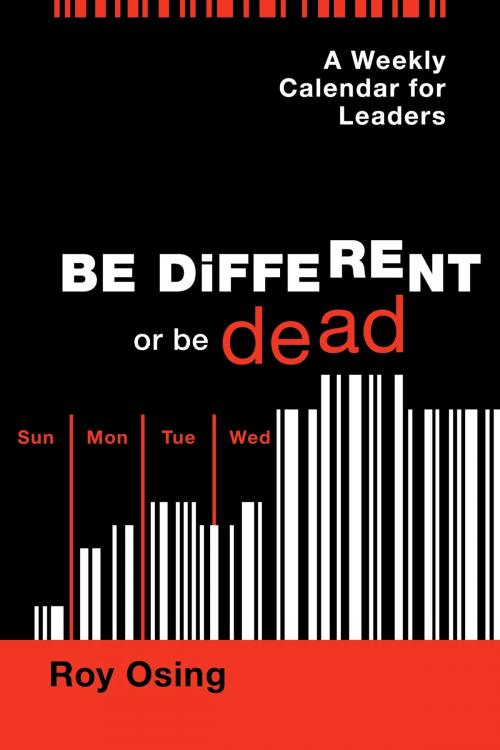A Weekly Calendar for Leaders
Be Different or be Dead
Business & Finance, Management & Leadership, Leadership| Author: | Roy Osing | ISBN: | 9781483551494 |
| Publisher: | BookBaby | Publication: | March 16, 2015 |
| Imprint: | Language: | English |
| Author: | Roy Osing |
| ISBN: | 9781483551494 |
| Publisher: | BookBaby |
| Publication: | March 16, 2015 |
| Imprint: | |
| Language: | English |
Leaders require context for what they do and how they spend their time. A philosophy that guides their behavior and the things they treat as a priority. Without context, leaders tend not to lead. They flit. They simply follow their nose and spend their time on the crisis of the day. They manage the momentum of the organization rather than disrupting it based on the need to respond to changes in their environment that shout out a new direction. For me, the appropriate leadership context for today’s rapidly changing and unpredictable world should be all about serving people; people "on the inside" – employees, and people "on the outside" – customers. Serving employees… Not directing, commanding and controlling them. Not telling them what to do as they go about performing their daily jobs. Not dictating orders for them to follow. Rather, establishing the picture of the journey to be taken, relating it to their specific job and enabling them to take it with you. This philosophy starts with the question “How can I help?” Helping by removing the barriers that prevent them from doing the job they want to do. By freeing them from organizational bureaucracy that stultifies their efforts. Serving customers… Not flogging products and services at them. Not forcing them to take what you supply. Not treating them like a faceless entity in the crowd. Rather, positioning the organization to respond to their needs, wants and desires; to subordinate its profit motives and declare the customer as the lead priority. Designing solutions and creating memorable experiences for them. By delivering happiness to them every time they engage with some aspect of your organization. You can't plan your week without getting your thinking straight on which philosophy YOU believe in as a leader. Do you want to control and direct people or do you want to serve and take care of them? For some, this is a difficult issue. I have dealt with many managers who found the idea of serving anyone repugnant. After all, if the command and control approach were good enough to get them to where they are, why should they change? For these managers, subordinating oneself to another person is completely out of their comfort zone. The issue is: which leadership philosophy better serves an organizational strategy today in a world where long term success and survival depends on the ability to stand out from the competitive herd and capture the hearts and minds of people? Where strategy execution separates the winners from the losers; where employee engagement determines if your game plan rocks or goes down in flames. My money's on serving. But you have to choose for yourself. If you decide to serve rather than control, this book is for you. I will show you some simple, practical things you can do every day of the week to promulgate serving both within your organization where your warriors live, and on the outside where customers and competitors live. I don’t expect you to do everything I suggest. But I do hope you pick a handful of ideas that excite you enough to give them a go. Focus on 3 critical things and do a brilliant job on them as opposed to trying to do "the possible many" and dilute your efforts on all of them. Serving leadership is a journey. It will never be over. You will never finish. But you can (and must, if you want to make a difference) begin. Get out of the starting gate. Take baby steps and learn from them.
Leaders require context for what they do and how they spend their time. A philosophy that guides their behavior and the things they treat as a priority. Without context, leaders tend not to lead. They flit. They simply follow their nose and spend their time on the crisis of the day. They manage the momentum of the organization rather than disrupting it based on the need to respond to changes in their environment that shout out a new direction. For me, the appropriate leadership context for today’s rapidly changing and unpredictable world should be all about serving people; people "on the inside" – employees, and people "on the outside" – customers. Serving employees… Not directing, commanding and controlling them. Not telling them what to do as they go about performing their daily jobs. Not dictating orders for them to follow. Rather, establishing the picture of the journey to be taken, relating it to their specific job and enabling them to take it with you. This philosophy starts with the question “How can I help?” Helping by removing the barriers that prevent them from doing the job they want to do. By freeing them from organizational bureaucracy that stultifies their efforts. Serving customers… Not flogging products and services at them. Not forcing them to take what you supply. Not treating them like a faceless entity in the crowd. Rather, positioning the organization to respond to their needs, wants and desires; to subordinate its profit motives and declare the customer as the lead priority. Designing solutions and creating memorable experiences for them. By delivering happiness to them every time they engage with some aspect of your organization. You can't plan your week without getting your thinking straight on which philosophy YOU believe in as a leader. Do you want to control and direct people or do you want to serve and take care of them? For some, this is a difficult issue. I have dealt with many managers who found the idea of serving anyone repugnant. After all, if the command and control approach were good enough to get them to where they are, why should they change? For these managers, subordinating oneself to another person is completely out of their comfort zone. The issue is: which leadership philosophy better serves an organizational strategy today in a world where long term success and survival depends on the ability to stand out from the competitive herd and capture the hearts and minds of people? Where strategy execution separates the winners from the losers; where employee engagement determines if your game plan rocks or goes down in flames. My money's on serving. But you have to choose for yourself. If you decide to serve rather than control, this book is for you. I will show you some simple, practical things you can do every day of the week to promulgate serving both within your organization where your warriors live, and on the outside where customers and competitors live. I don’t expect you to do everything I suggest. But I do hope you pick a handful of ideas that excite you enough to give them a go. Focus on 3 critical things and do a brilliant job on them as opposed to trying to do "the possible many" and dilute your efforts on all of them. Serving leadership is a journey. It will never be over. You will never finish. But you can (and must, if you want to make a difference) begin. Get out of the starting gate. Take baby steps and learn from them.















